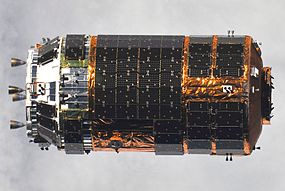HTV-R
 |
|
|---|---|
| Description | |
| Role: | Automated cargo spacecraft to resupply the International Space Station |
| Crew: | None |
| Dimensions | |
| Height: | ~9.8 m (including thrusters) |
| Diameter: | 4.4 m |
| Spacecraft Mass: | 10,500 kg |
| Total Launch Payload: | 6,000 kg / 6,200 kg |
| Pressurized Payload: | 5,200 kg |
| Unpressurized Payload: | 1,500 kg / 1,900 kg (HTV-6 - ) |
| Return Payload: | None |
| Mass at launch: | 16.5 ton |
| Pressurized Volume: | 14 m3 |
| Performance | |
| Endurance: | Solo flight about 100 hours, stand-by more than a week, docked with the ISS about 30 days |
| Apogee: | 460 km |
| Perigee: | 350 km |
| Inclination: | 51.6 degrees |
The H-II Transfer Vehicle (HTV), also called Kounotori (こうのとり Kōnotori, "Oriental stork" or "white stork"), is an automated cargo spacecraft used to resupply the Kibō Japanese Experiment Module (JEM) and the International Space Station (ISS). The Japan Aerospace Exploration Agency (JAXA) has been working on the design since the early 1990s. The first mission, HTV-1, was originally intended to be launched in 2001. It launched at 17:01 UTC on 10 September 2009 on an H-IIB launch vehicle. The name Kounotori was chosen for the HTV by JAXA because "a white stork carries an image of conveying an important thing (a baby, happiness, and other joyful things), therefore, it precisely expresses the HTV's mission to transport essential materials to the ISS".
The HTV is about 9.8 m long (including maneuvering thrusters at one end) and 4.4 m in diameter. Total mass when empty is 10.5 tonnes (11.6 short tons), with a maximum total payload of 6,000 kilograms (13,000 lb; 6.0 t; 6.6 short tons), for a maximum launch weight of 16.5 tonnes (18.2 short tons). The HTV is comparable in function to the Russian Progress, European ATV, commercial Dragon, and commercial Cygnus spacecraft, all of which bring or are planned to bring supplies to the ISS. Like the ATV, the HTV carries more than twice the payload of the Progress, but is launched less than half as often. Unlike Progress capsules and ATVs, which dock automatically, HTVs and American commercial spacecraft approach the ISS in stages, and are signaled by ISS crew or ground control to continue from one holding point to the next. Once they reach their closest parking orbit to the ISS, crew grapple them using the robotic arm Canadarm2 and berth them to an open berthing port on the Harmony module.
...
Wikipedia
